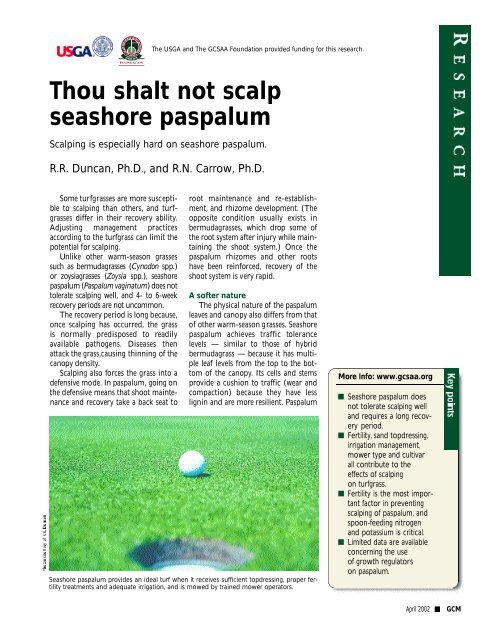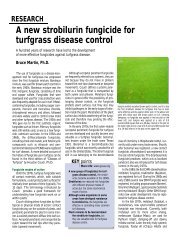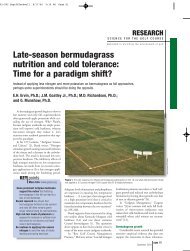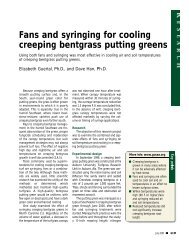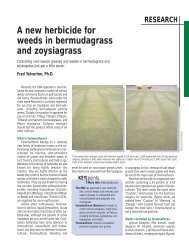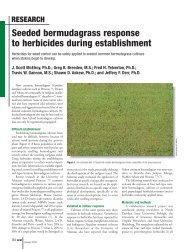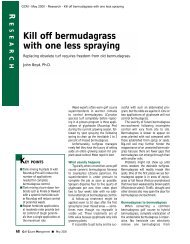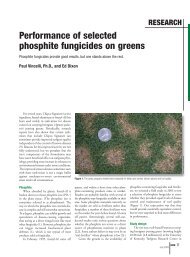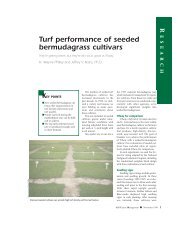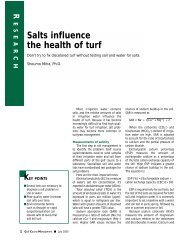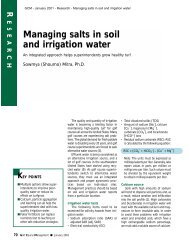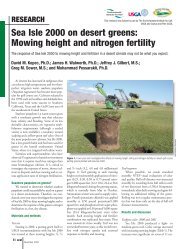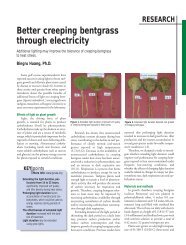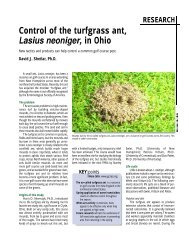Thou shalt not scalp seashore paspalum - GCSAA
Thou shalt not scalp seashore paspalum - GCSAA
Thou shalt not scalp seashore paspalum - GCSAA
Create successful ePaper yourself
Turn your PDF publications into a flip-book with our unique Google optimized e-Paper software.
The USGA and The <strong>GCSAA</strong> Foundation provided funding for this research.<br />
<strong>Thou</strong> <strong>shalt</strong> <strong>not</strong> <strong>scalp</strong><br />
<strong>seashore</strong> <strong>paspalum</strong><br />
Scalping is especially hard on <strong>seashore</strong> <strong>paspalum</strong>.<br />
R.R. Duncan, Ph.D., and R.N. Carrow, Ph.D.<br />
Some turfgrasses are more susceptible<br />
to <strong>scalp</strong>ing than others, and turfgrasses<br />
differ in their recovery ability.<br />
Ad ju s ting managem ent practi ce s<br />
according to the turfgrass can limit the<br />
potential for <strong>scalp</strong>ing.<br />
Un l i ke other warm - s e a s on gra s s e s<br />
su ch as bermu d a grasses (Cyn od o n s pp. )<br />
or zoys i a grasses (Zoys i a s pp. ), s e a s h ore<br />
p a s p a lum (Pa s palum va gi n a tu m) does <strong>not</strong><br />
to l era te <strong>scalp</strong>ing well , and 4- to 6-wee k<br />
recovery peri ods are <strong>not</strong> uncom m on .<br />
The recovery period is long because,<br />
once <strong>scalp</strong>ing has occurred, the grass<br />
is norm a lly pred i s po s ed to re ad i ly<br />
ava i l a ble pathogen s . Diseases then<br />
attack the grass,causing thinning of the<br />
canopy density.<br />
Scalping also forces the grass into a<br />
defensive mode. In <strong>paspalum</strong>, going on<br />
the defensive means that shoot maintenance<br />
and recovery take a back seat to<br />
root mainten a n ce and re - e s t a bl i s h-<br />
ment, and rhizome development. (The<br />
oppo s i te con d i ti on usu a lly exists in<br />
bermudagrasses, which drop some of<br />
the root system after injury while maintaining<br />
the shoot system.) Once the<br />
p a s p a lum rh i zomes and other roo t s<br />
have been reinforced, recovery of the<br />
shoot system is very rapid.<br />
A softer nature<br />
The physical nature of the <strong>paspalum</strong><br />
leaves and canopy also differs from that<br />
of other warm-season grasses. Seashore<br />
p a s p a lum ach i eves traffic to l era n ce<br />
l evels — similar to those of hybri d<br />
bermudagrass — because it has multiple<br />
leaf levels from the top to the bottom<br />
of the canopy. Its cells and stems<br />
provide a cushion to traffic (wear and<br />
com p acti on) because they have less<br />
lignin and are more resilient. Paspalum<br />
Seashore <strong>paspalum</strong> provides an ideal turf when it receives sufficient topdressing, proper fertility<br />
treatments and adequate irrigation, and is mowed by trained mower operators.<br />
More Info: www.gcsaa.org<br />
■ Seashore <strong>paspalum</strong> does<br />
<strong>not</strong> tolerate <strong>scalp</strong>ing well<br />
and requires a long recovery<br />
period.<br />
■ Fertility, sand topdressing,<br />
irrigation management,<br />
mower type and cultivar<br />
all contribute to the<br />
effects of <strong>scalp</strong>ing<br />
on turfgrass.<br />
■ Fertility is the most important<br />
factor in preventing<br />
<strong>scalp</strong>ing of <strong>paspalum</strong>, and<br />
spoon-feeding nitrogen<br />
and potassium is critical.<br />
■ Limited data are available<br />
concerning the use<br />
of growth regulators<br />
on <strong>paspalum</strong>.<br />
April 2002<br />
GCM
GCM April 2002<br />
canopies therefore have a soft, silky feel<br />
com p a red to the sti f fer canopies of<br />
bermudagrass and zoysiagrass.<br />
The softer nature of the <strong>paspalum</strong><br />
canopy means that the actual mowing<br />
height in the field is very close to the<br />
bench setting because the canopy does<br />
<strong>not</strong> slow down the mower as much.Any<br />
management factor that further softens<br />
the canopy (excess nitrogen, excess irrigation,<br />
poor drainage,low potassium or<br />
insufficient topdressing) can increase<br />
the potential for <strong>scalp</strong>ing.<br />
Scalping: causes and prevention<br />
Practices that minimize the potential<br />
for <strong>scalp</strong>ing in <strong>paspalum</strong> are the same<br />
as those for other grasses, but adjusted<br />
to <strong>paspalum</strong>’s specific requirements.<br />
1. Fertility<br />
Fertility, especially excess nitrogen<br />
(which causes rapid shoot growth and<br />
excess su cc u l en ce) and inadequ a te<br />
potassium,is the most important factor<br />
in reducing paspalu m’s su s cepti bi l i ty<br />
to <strong>scalp</strong>ing.<br />
Excess nitrogen should <strong>not</strong> be<br />
applied to this grass at any time. SeaIsle<br />
1 <strong>paspalum</strong> (www.seaisle1.com) maintains<br />
good color even at low nitrogen<br />
Tim Hiers, CGCS, mows a <strong>paspalum</strong> green at The Old Collier GC in Naples, Fla. Mower type,<br />
surface smoothness and firmness, and individual mower operator skills can all play a part in<br />
whether a green is <strong>scalp</strong>ed.<br />
levels, so nitrogen is seldom necessary<br />
for color retention. Nitrogen should be<br />
primarily applied to control or regulate<br />
shoot growth rates.<br />
Adequ a te ava i l a ble po t a s s ium is cri t-<br />
ical for high leaf tu r gor pre s su re mainten<br />
a n ce and root sys tem devel opm en t ,<br />
m a i n ten a n ce and functi on a l i ty. It is also<br />
the first line of defense against many leaf<br />
s pot diseases. Se a s h ore <strong>paspalum</strong> has a<br />
h i gh requ i rem ent for po t a s s ium and is<br />
h i gh ly ef f i c i ent in using it. Th erefore ,<br />
adopting a spoon - feeding ferti l i ty program<br />
(light ra tes app l i ed frequ en t ly or<br />
use of h i gh - percen t a ge slow - rel e a s e<br />
n i trogen produ cts) for both nitrogen<br />
and po t a s s ium is essen ti a l .<br />
Like other grasses,<strong>paspalum</strong> is most<br />
prone to <strong>scalp</strong>ing during the transition<br />
from grow-in fertility and topdressing<br />
programs to mature turf stand mainten<br />
a n ce progra m s . Se a s h ore paspalu m<br />
responds readily to available nitrogen<br />
(because of its high nitrogen uptake<br />
and use efficiency). Therefore, it is necessary<br />
to wean the grass off the aggressive<br />
nitrogen fertility program necessary<br />
for grow-in. Otherwise, the turf<br />
will be very prone to <strong>scalp</strong>ing during<br />
the tra n s i ti on peri od as the cut ti n g<br />
height is lowered.<br />
Dec rease the mowing hei ght gradu a lly<br />
for paspalu m , n orm a lly by 0.02–0.03-<br />
i n ch increm ents over 2–3-day peri od s<br />
once the nitrogen levels have been<br />
redu ced and shoot growth ra te is slowed .<br />
One indicator that the nitrogen fertility<br />
program is lean enough is when<br />
dollar spot (Sclerotinia) starts showing<br />
up on the <strong>paspalum</strong>. Then adequate<br />
nitrogen can be maintained by spoonfeeding<br />
without causing excess shoot<br />
growth. Nitrogen applications should<br />
be avoided until stolons start growing<br />
from the remaining shoots and the disease<br />
problem is under control. This<br />
grass responds rapidly to soluble nitrogen<br />
source s , wh i ch are ei t h er used<br />
immediately or stored for later use.<br />
Ch oi ce of ferti l i zer type (gra nu l a r,<br />
l i qu i d ), m et h od of a pp l i c a ti on (ferti gati<br />
on , foliar spray, gra nular) and solu bi l-<br />
i ty (percen t a ge slow rel e a s e , h i gh ly solu-
le) all must be determ i n ed in con cert<br />
with bu d get con s i dera ti on s . With pasp<br />
a lu m , adopti on of a lean-and-mean<br />
a pp l i c a ti on stra tegy in com p l i a n ce wi t h<br />
envi ron m ental stew a rdship issues is po s-<br />
s i bl e .Mac ronutri ents like nitrogen , po t a s-<br />
s ium and magn e s ium and spoon - fed<br />
m i c ronutri ents (espec i a lly manga n e s e )<br />
a re important to maintain adequ a te , but<br />
<strong>not</strong> too ra p i d , s h oot growth ra te s .<br />
2. Sand topdressing<br />
On <strong>paspalum</strong> (and bermu d a gra s s )<br />
go l f green s , sand top d ressing du ri n g<br />
grow-in must be applied at frequencies<br />
and ra tes that maintain a thin mat<br />
(thatch with high levels of sand so that<br />
the sand provi des a firm su rf ace ) .<br />
In adequ a te top d ressing produ ces a<br />
s om ewhat puffy thatch layer, wh i ch<br />
results in a much less firm surface that is<br />
susceptible to <strong>scalp</strong>ing. The higher mowing<br />
heights and rapid turf growth rates<br />
required for grow-in make it easy to<br />
apply insufficient sand topdressing for<br />
true mat development.<br />
In the best-case scen a ri o, a firm su r-<br />
f ace is ach i eved du ring grow - i n .<br />
Devel oping this ideal su rf ace du ring the<br />
tra n s i ti on peri od is also accept a bl e ,<br />
a l t h o u gh it is more difficult and requ i re s<br />
f requ ent light verti c ut ti n g. If a firm su r-<br />
f ace is <strong>not</strong> ach i eved by the time grow - i n<br />
has been com p l eted , it may take som e<br />
time to lower mowing hei ghts to playa bl e<br />
l evels in an ef fort to avoid <strong>scalp</strong>ing.<br />
Light verticutting aids in preventing<br />
<strong>scalp</strong>ing du ring the tra n s i ti on from<br />
grow-in to mature turf by allowing more<br />
topdressing sand to integrate into the<br />
turf surface. Heavy verticutting should<br />
be avoided, however.<br />
Good topdressing sand integrates easily<br />
into <strong>seashore</strong> <strong>paspalum</strong> surfaces even<br />
at close mowing heights and without<br />
verticutting when applied at light rates<br />
of 0.5 to 4.0 cubic feet of topdressing per<br />
1,000 square feet.<br />
3. Irrigation management<br />
Pa s p a lum is very re s pon s ive to irri gati<br />
on du ra ti on and frequ en c y. E m p l oyi n g<br />
f requ ent irri ga ti on events of s h ort du ra-<br />
ti on re sults in a shall ow root sys tem and<br />
grass that wi ll <strong>not</strong> ex h i bit its full po tential<br />
for dro u ght re s i s t a n ce and tends to<br />
grow ra p i dly, e s pec i a lly if ferti l i ty is<br />
h i gh . (“ Frequ ent irri ga ti on events of<br />
s h ort du ra ti on” means irri ga ting every<br />
1-3 days at ra tes that on ly rewet the su r-<br />
f ace 4 inches of the root zone ra t h er<br />
than rech a r ging the whole roo t - zon e<br />
depth.) Un der these con d i ti on s , t h e<br />
grass also tends to be more su cc u l en t<br />
and ex h i bits too mu ch shoot growt h .<br />
In f requ ent irri ga ti on app l i c a ti ons of<br />
l on ger du ra ti on (irri ga ting every 4-7 days<br />
with su f f i c i ent water to rech a r ge the roo t<br />
zon e ,of ten abo ut 0.5 to 1.0 inch of w a ter<br />
on a sand green) wi ll train the root system<br />
deeper into the soil prof i l e ,while the<br />
s h a ll ower roots take adva n t a ge of ra i n f a l<br />
and irri ga ti on even t s .Hi gh eva po tra n s p i-<br />
ra ti on ra tes and dro u ght stre s s<br />
ep i s odes have little ef fect on<br />
grass with a deep root sys tem<br />
and a high rh i zome nu m ber.<br />
Periods of drought stress<br />
h a rden the grass to envi ronm<br />
ental stre s s e s .<br />
Excess irri ga ti on causes<br />
ad d i ti onal su cc u l en ce in the<br />
tu rf l e aves and a sof ter su r-<br />
f ace zon e ,wh i ch can also lead<br />
to <strong>scalp</strong>ing. The grass can<br />
t a ke excess water and prol<br />
on ged wet soi l - profile con d i-<br />
ti on s , but <strong>scalp</strong>ing po ten ti a l<br />
i n c reases accord i n gly, u su a lly<br />
because the tu rf su rf ace is less<br />
f i rm and is more prone to tra f f i c - rel a ted<br />
go u ging of the su rf ace . Poor dra i n a ge<br />
can also produ ce the same re sults in wet<br />
eco s ys tem s .<br />
The grower must balance the management<br />
of salts with supplying judicious<br />
quantities of water for the turf<br />
while complying with water conservation<br />
requirements. Use of highly saline<br />
water may alter the decision to verticut<br />
lightly, because the cut ends of the turf<br />
could be more prone to salt desiccation<br />
and injury.<br />
4. Mower type<br />
Especially on greens, the type of<br />
Scalping predisposes <strong>seashore</strong> <strong>paspalum</strong> to diseases<br />
such as Helminthosporium, indicated by the<br />
reddish-brown color of the grass.<br />
April 2002<br />
GCM
mower used can cause or prevent <strong>scalp</strong>ing.<br />
Some new mowers cause minimal<br />
<strong>scalp</strong>ing problems regardless of grass<br />
type. Mowers with dual rollers are less<br />
likely to <strong>scalp</strong> the grass than are mowers<br />
with only a single roller. Of course, surface<br />
smoothness and firmness and individual<br />
mower operator skills affect the<br />
operation of any greens mower. Blade<br />
sharpness and the use of brushes vs.<br />
groomers also can influence <strong>scalp</strong>ing.<br />
5. Cultivar<br />
Some <strong>paspalum</strong> cultiva rs , su ch as<br />
deriva tives of the old Ad a l ayd or<br />
Exc a l i bur sources that ori gi n a ted from<br />
Au s tra l i a ,a re more sen s i tive to <strong>scalp</strong>ing.<br />
Cu l tiva rs with lower levels of s a l i n i ty<br />
to l era n ce seem to be more prone to<br />
s c a l p i n g, but all cultiva rs can be <strong>scalp</strong>ed .<br />
Growth regulators<br />
Growth reg u l a tors are com m on ly<br />
applied to bermudagrasses to minimize<br />
<strong>scalp</strong>ing, especially in mid- to late summer.<br />
Growth regulator use could help<br />
on <strong>seashore</strong> <strong>paspalum</strong>, but limited data<br />
are available. Given what is currently<br />
known about plant growth regulator<br />
re s pon s e , Primo (tri n ex a p ac - et hyl )<br />
should be used cauti o u s ly with this<br />
grass, and small areas should be tested<br />
before applying the chemical to large<br />
areas. Identical rates applied at different<br />
locations (Hawaii,Florida and Georgia)<br />
have given different results — some<br />
positive and some negative.<br />
Primo is somewhat effective in suppressing<br />
seed h e ads in paspalu m .<br />
App l i c a ti ons of Cutless (flu pri m i do l )<br />
will suppress growth significantly above<br />
85 F and below 75 F. Trimmit (paclobutrazol)<br />
and Proxy (ethephon) have been<br />
applied at varying rates and timing with<br />
mimimal side effects,and both are effective<br />
at seedhead suppression, although<br />
envi ron m ental interacti ons have<br />
occurred (as <strong>not</strong>ed above for Primo).<br />
E m b a rk (mef lu i d i de) and malei c<br />
hydrazide responses on <strong>paspalum</strong> are<br />
unknown. Use of irrigation water with<br />
high salt levels will also have a growth<br />
regulator effect.<br />
After <strong>scalp</strong>ing<br />
O n ce <strong>scalp</strong>ing has occ u rred and a disease<br />
or diseases have attacked the gra s s ,<br />
determine wh i ch pathogen(s) are causing<br />
the probl em . A topical fungi c i de wi ll<br />
s top the pathogen from spre ad i n g.<br />
Aera ti on fo ll owed by top d ressing and<br />
a pp l i c a ti on of a po t a s s ium + cyto k i n i n<br />
produ ct wi ll help rei n force the root system<br />
and lead to a horm onal shift tow a rd<br />
n ew shoot produ cti on at a faster recovery<br />
ra te . Using cytokinin is essen tial on<br />
s a l t - a f fected sites because salt acts as a<br />
growth reg u l a tor.<br />
An o t h er opti on is app lying gra nu l a r<br />
and foliar manganese to co u n ter take - a ll<br />
( Ga eu m a n n o myces gra m i n i s) disease,wh i ch<br />
is favored wh en <strong>scalp</strong>ing occ u rs and environ<br />
m ental con d i ti ons are favora bl e. ■<br />
References<br />
1. Carrow, R.N., and R.R. Duncan. 1998. Saltaffected<br />
turfgrass sites: assessment and management.<br />
Ann Arbor Press. Chelsea, Mich.<br />
2. Carrow, R.N., D.V. Waddington and P.E. Rieke.<br />
2 0 0 1 . Tu rfgrass soil ferti l i ty and ch em i c a l<br />
problems: assessment and management. Ann<br />
Arbor Press. Chelsea, Mich.<br />
3. Duncan,R.R.2001. All <strong>seashore</strong> <strong>paspalum</strong>s are<br />
<strong>not</strong> created equal. Golf Course Management<br />
69(6):54-60.<br />
4. Du n c a n , R . R . , and R.N. Ca rrow. 2 0 0 0 .<br />
Seashore <strong>paspalum</strong> — the environmental turfgrass.<br />
Ann Arbor Press, Chelsea, Mich.<br />
Inadequate sand topdressing during grow-in can produce a puffy thatch layer, which results in<br />
a softer surface that is susceptible to <strong>scalp</strong>ing.<br />
R . R . Du n c a n , Ph . D. (e-mail: rdu n c a n @ ga e s .<br />
griffin.peachnet.edu), and R.N. Carrow, Ph.D., are<br />
researchers at the University of Georgia — Griffin.<br />
GCM April 2002


